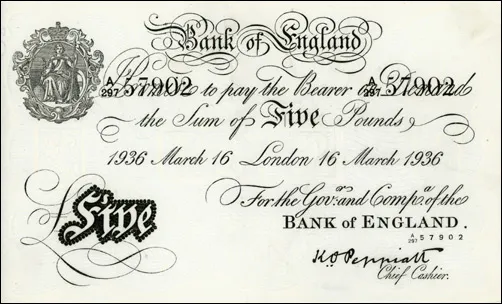The Nazis Planned to Bomb Britain With Forged Bank Notes
But Operation Bernhard never made it rain
/https://tf-cmsv2-smithsonianmag-media.s3.amazonaws.com/filer/32/d4/32d49f88-0df8-472d-b2e6-19f17ec1d1d8/42-22089542.jpg)
The Second World War may have been the bloodiest war, but it also could be considered the weirdest—a conflict full of foiled plans to do everything from kidnap the pope and lock him up in a castle to strap miniature bombs on bats and drop them on Japanese cities. Add one to the “strange, but true list”: as Richard Dunley blogs for Britain’s National Archives, the Nazis planned to bomb Britain with clouds of forged bank notes.
Of course, the idea wasn’t intended to "make it rain" for English citizens—rather, writes Dunley, it was designed to destabilize the British economy. But the plot was uncovered when Alfred Naujocks, a German intelligence officer, was captured and interrogated in 1944, Dunley writes. Naujocks was already infamous before his capture: Five years earlier, he had organized and carried out the so-called Gleiwitz incident, seizing a Polish radio station and transmitting an anti-German speech. Along with other supposedly anti-German events orchestrated by the Germans themselves, the incident gave Germany an excuse to invade Poland and World War II was set into motion.
Nanjucks told his interrogators that he was in charge of spearheading a campaign called Operation Bernhard designed to undermine the British economy. Naujocks and other Nazis used 140 Jewish prisoners at Sachsenhausen concentration camp, who they trained to forge British bank notes. They even contracted with a special factory to provide the proper paper for British notes. But CIA historian Kevin Ruffner writes that wartime shortages meant that only about 10 percent of the 134 million British pounds produced by the forgers was good enough to be circulated.

“The instructions came from Hitler himself, who wanted to drop huge quantities of forged bank notes from German aircraft[s],” writes Dunley. Hitler apparently hoped that the scheme would dangerously inflate the British wartime economy and weaken Great Britain, making it an easier target for a German invasion. The Nazis also planned to counterfeit American dollars with the hopes of doing the same across the Atlantic to the United States.
Of course, that plot never became real. Though Germany did use some of the forged money to import supplies, Naujocks and his team had to move their top secret forgery center from camp to camp during the rest of the war. Finally, at the end of the war, desperate Nazis burned huge amounts of British “currency” and dumped some of it in a remote Austrian lake. Years later, some of the money was found at the bottom of Lake Toplitz and was incinerated by British authorities.
The forged money may not have done its job, but England didn’t take any chances. After the war, the Bank of England withdrew all notes with a value of more than five pounds as soon as it had designed and printed new paper money. For a scheme that didn’t work, Operation Bernhard sure affected plenty of people—and will go down in history as one of wartime’s most over-the-top secret plots.
/https://tf-cmsv2-smithsonianmag-media.s3.amazonaws.com/accounts/headshot/erin.png)
/https://tf-cmsv2-smithsonianmag-media.s3.amazonaws.com/accounts/headshot/erin.png)